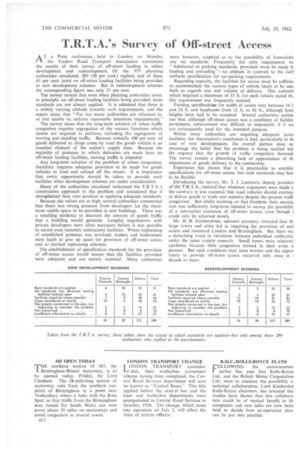T.R.T.A.'s Survey of Off-street Access
Page 46

If you've noticed an error in this article please click here to report it so we can fix it.
AT a Press conference held in London on Monday the Traders Road Transport Association announced the results of their survey of off-street loading in urban development and redevelopment. Of the 979 planning authorities circulated, 289 (30 per cent.) replied, and of these 43 per cent, insist on off-street loading facilities being provided in new development schemes. But in redevelopment schemes the corresponding figure was only 25 per cent .
The survey reveals that even when planning authorities insist, in principle, on off-street loading facilities being provided, basic standards are not always applied. It is admitted that there is a widely varying attitude towards such requirements, and the report states that "Far too many authorities are reluctant to. or feel unable to, enforce reasonable minimum requirements."
The survey states that the long-term solution of urban traffic congestion requires segregation of the various functions which streets are required to perform, including the segregation of moving and standing traffic. Because virtually 100 per cent, of goods delivered to shops come by road the goods vehicle is an essential element of the nation's supply lines. Because the majority of premises to which deliveries are made have no off-street loading facilities, moving traffic is impeded.
Any long-term solution of the problem of urban congestion, therefore, requires adequate provision to be made for goods vehicles to load and unload off the streets. It is imperative that every opportunity should be taken to provide such facilities when development schemes are under consideration.
Many of the authorities circulated welcomed the T.R.T.A.'s constructive approach to the problem and considered that it strengthened their own position in applying adequate standards.
• Because site values are so high, several authorities commented that there was strong pressure from developers for the maximum usable space to be provided in new buildings. There was a resulting tendency to discount the amount of goods traffic that a building would generate. Lengthy negotiations with private developers were often necessary before it was possible to secure even remotely satisfactory facilities. Where replanning of established premises was involved, traders and landowners were loath to give up space for provision of off-street access and so resisted replanning schemes.
The establishment of specification standards for the provision of off-street access would ensure that the facilities provided were adequate and not merely nominal. Many authorities were, however, sceptical as to the possibility of form ulatin any set standards. Frequently the only requirement wz "Additional to parking standards, provision must be made fr loading and unloading "—an attitude in contrast to the fairl uniform specification for car-parking requirements.
Regarding capacity, the facilities for access must be sufficier to accommodate the various types of vehicle likely to be uses both as regards size and volume of delivery. One authorit which imposed a minimum of 35 ft. for each vehicle stated thf this requirement was frequently resisted.
Existing specificatious for width of access vary between 16 f and 24 ft. and headroom from 12 ft. to 16 ft., although lowe heights have had to be accepted. Several authorities pointe out that, although off-street access was a condition of buildin permission, enforcement was difficult or impossible if it wa not subsequently used for the intended purpose.
Whilst more authorities are requiring adequate acces facilities. the Association's conclusion is that, particularly in th case of new developments, the overall picture does nc encourage the belief that the problem is being tackled wit: the urgency that the growth of traffic congestion demand The survey reveals a disturbing lack of appreciation of th importance ot goods delivery to the community.
Experience has shown that it is practicable to establisl specifications for off-street access, but such standards may hay to be flexible.
. Introducing the survey, M. S. J. Lamborn, deputy presiden of the T.R.T.A., insisted that whatever arguments were made ti the contrary it was essential that road vehicles should confirm. to deliver goods to trade and industry despite the present traffi: congestion. But whilst insisting on that freedom, their associa tion was sufficiently long-term minded to survey the possibilit: of a substantial extension of off-street access, even though i could only be achieved slowly.
Mr. FL R. Featherstone, national secretary, revealed that th, large towns and cities led in requiring the provision of sue] access and instanced London and Birmingham. But there wa a disturbing trend in variations between individual authoritie under the same county councils. Small towns were relativ0 apathetic because little congestion existed in their areas a present. But such conditions may soon worsen and the oppor tunity to provide off-street access occurred only once in decade or more.




















































































































